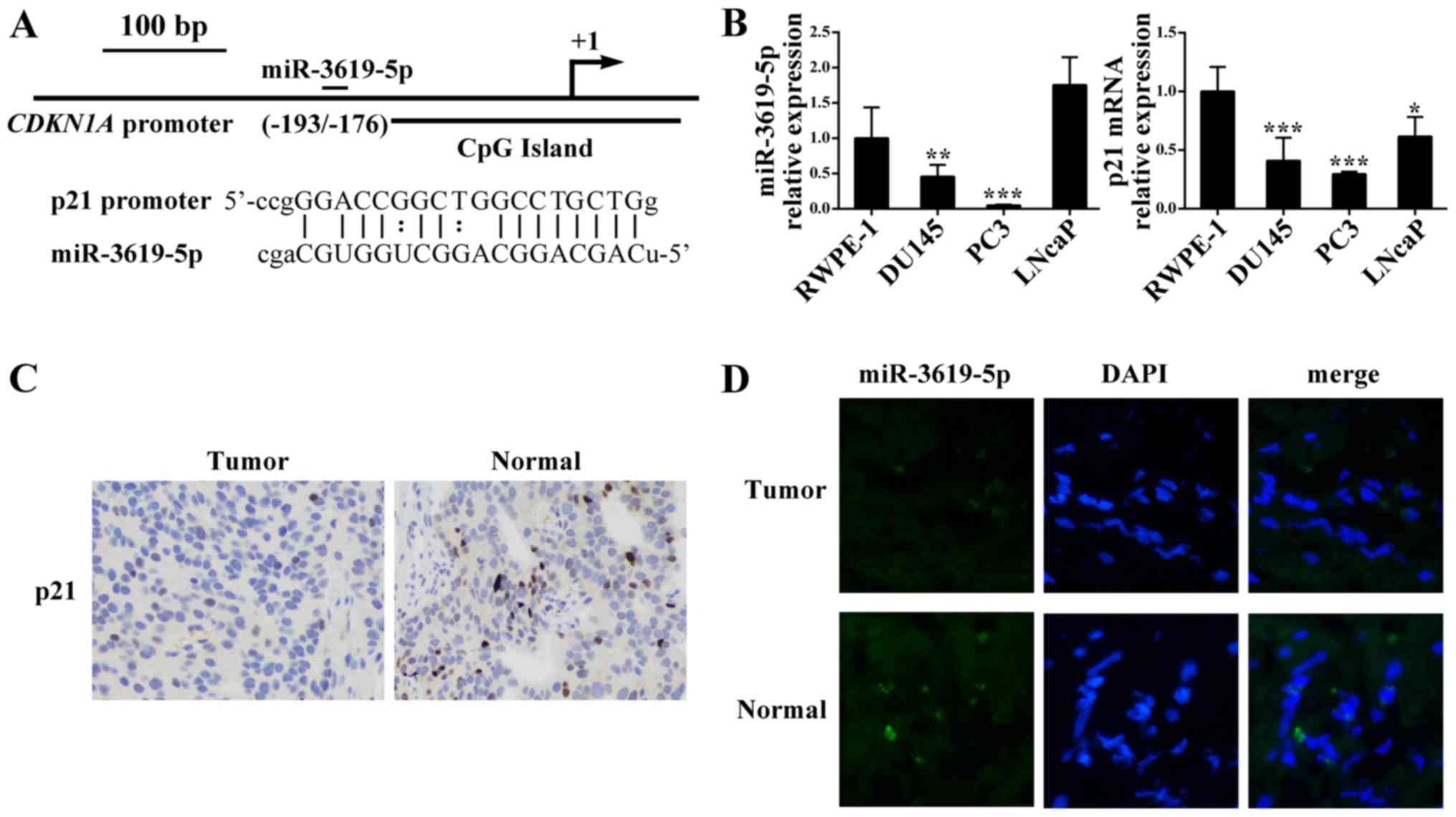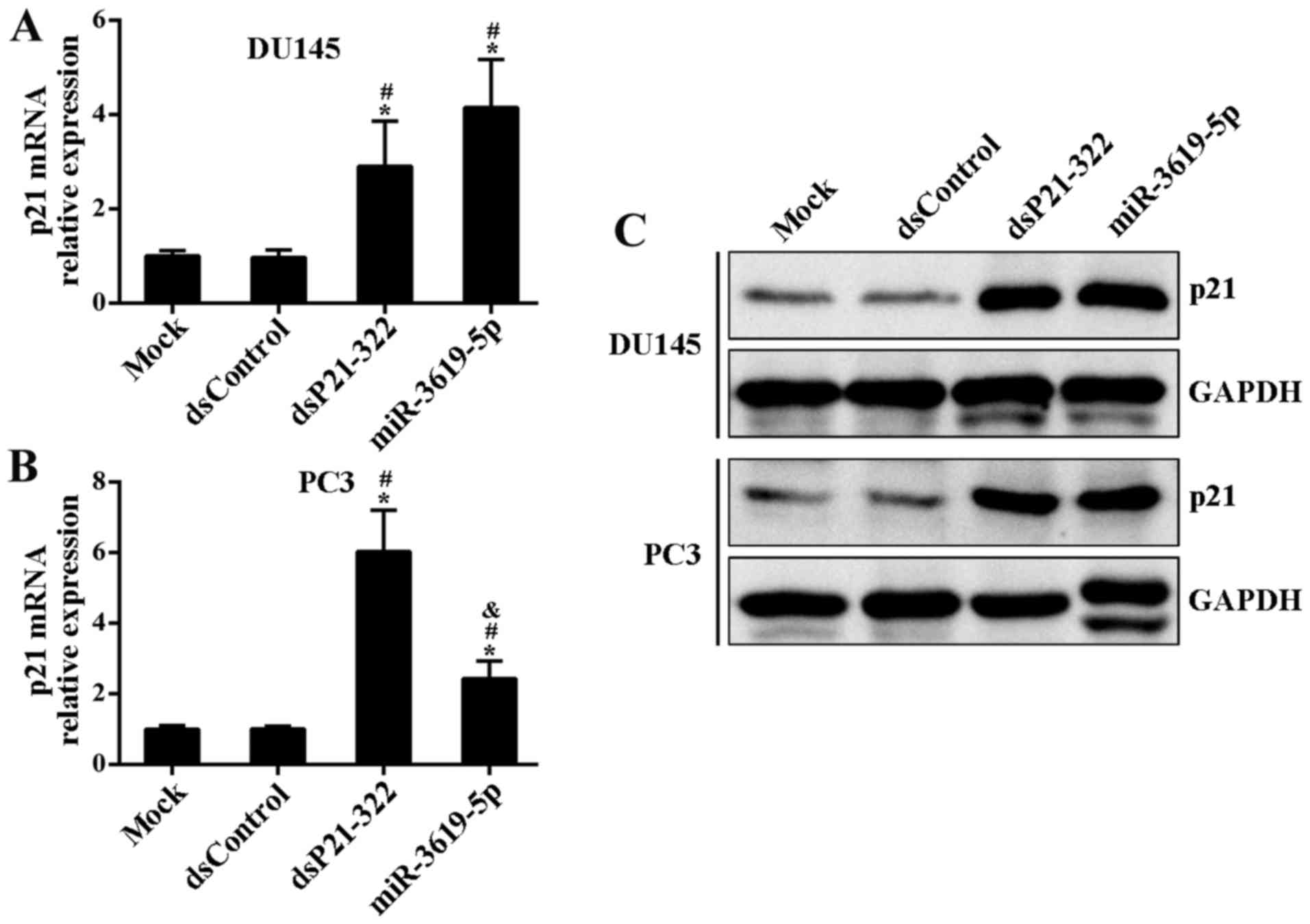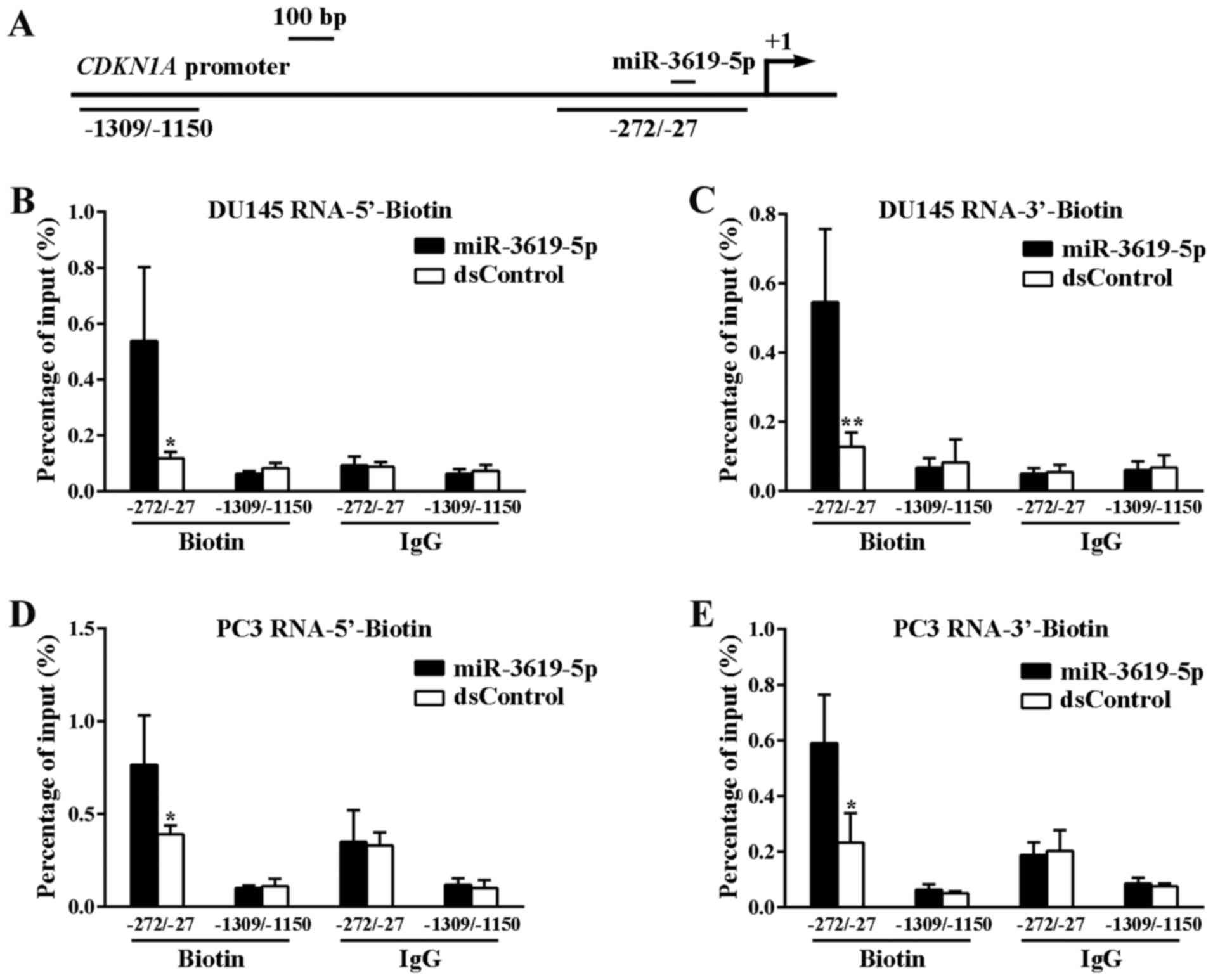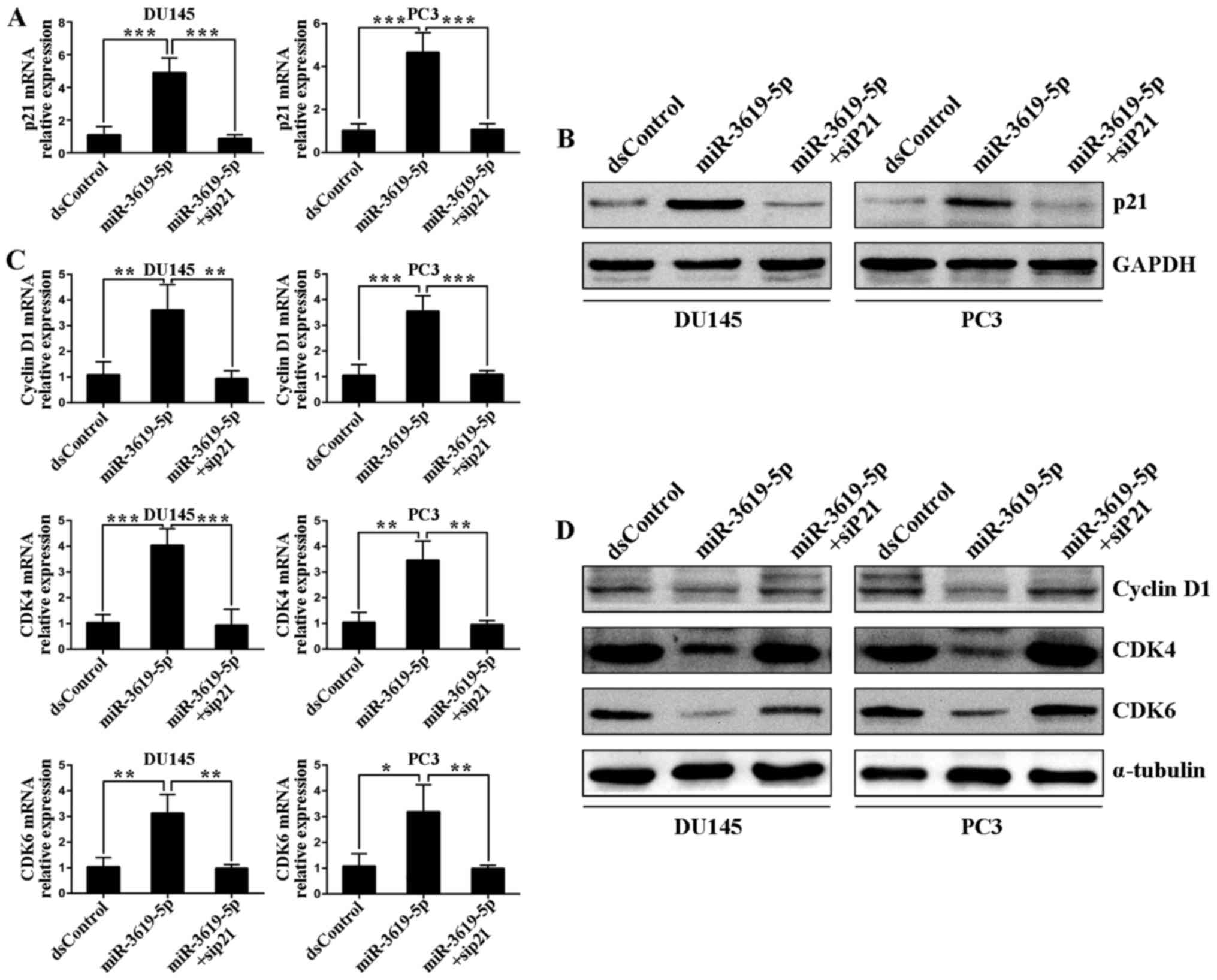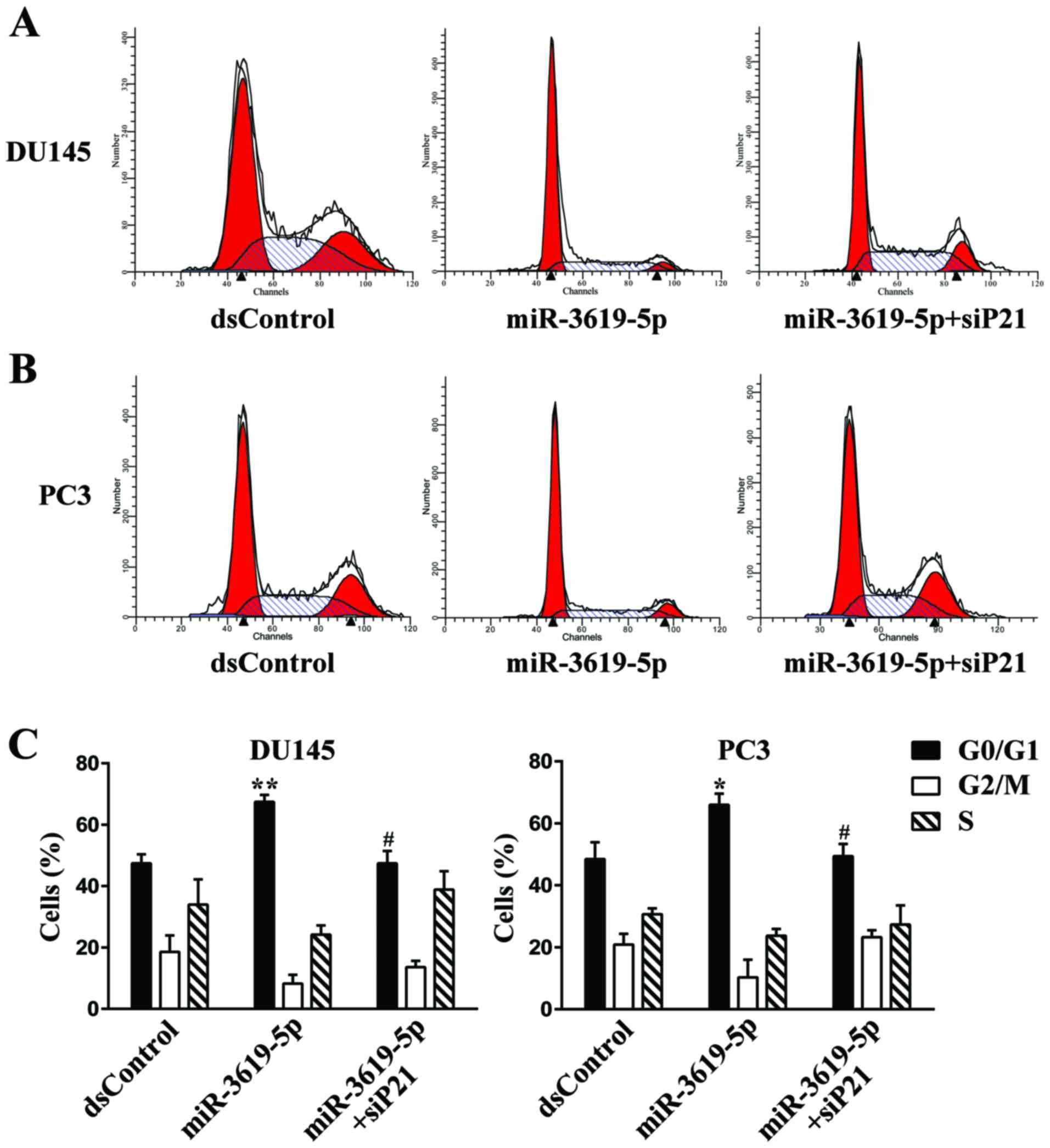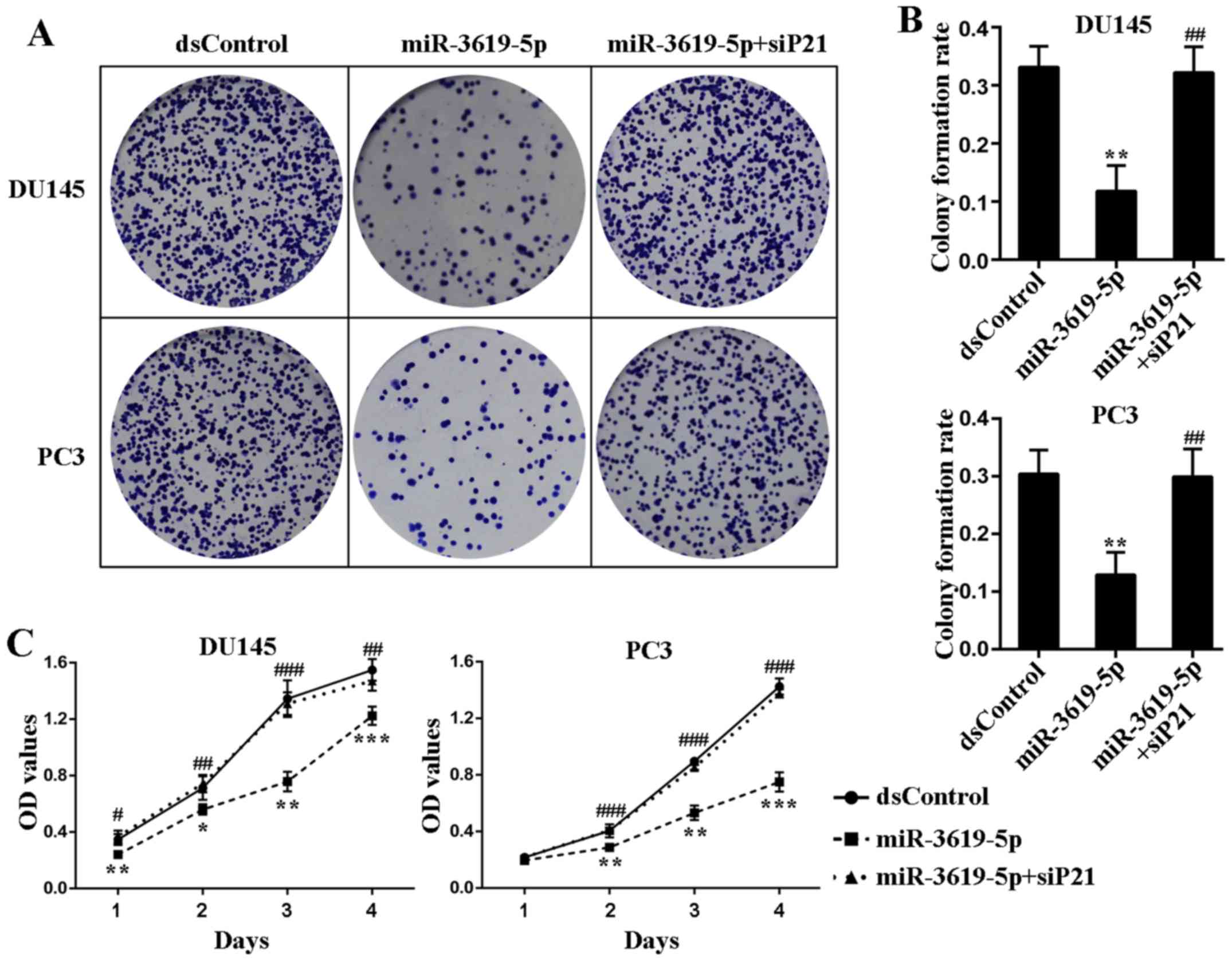miR-3619-5p inhibits prostate cancer cell growth by activating CDKN1A expression
- Authors:
- Published online on: November 16, 2016 https://doi.org/10.3892/or.2016.5250
- Pages: 241-248
Abstract
Introduction
Prostate cancer is the most prevalent cancer among men in the United States, with an estimated annual incidence of 180,890 new cases and 26,120 deaths as reported in 2016 (1). Likewise, the incidence and mortality rate of prostate cancer have sharply increased in China over the past few decades (2). Androgen deprivation is the mainstay of therapy for advanced prostate cancer. Unfortunately, most androgen-dependent prostate cancer patients progressed to a castration-resistant state after a median time of 18–24 months (3). Therefore, effective new therapies are needed to improve clinical care of prostate cancer patients.
It is known that exogenous small activating RNAs (saRNAs) are able to stimulate gene expression at the transcriptional level by targeting specific promoter regions, termed as RNA activation (RNAa) (4). Besides, the endogenous microRNAs (miRNAs) have also been implicated in induction of gene expression via the same mechanism (5). As a class of small non-coding RNA molecules, miRNAs play important roles in prostate cancer proliferation and apoptosis (6,7). In addition, downregulation of specific miRNAs in tumor tissues can lead to aberrant expression of their targeted genes, which are often involved in prostate cancer initiation, development and progression (8). Hereby, restoration of the specific miRNA in prostate tumors could be considered as a promising therapeutic strategy for prostate cancer.
Increased proliferative activity, often caused by impaired regulation of cell cycle, is the main characteristic of cancer cells. The CDKN1A gene is a broad-acting cyclin-dependent kinase inhibitor and encodes the p21 protein (9). Upregulated expression of CDKN1A by adenoviral vectors has been shown to inhibit prostate cancer growth both in vitro and in vivo (10). Thus, the CDKN1A gene is an ideal target for gain-of-function manipulation to suppress prostate cancer cells growth.
In the present study, a new miRNA (miR-3619-5p) was selected and transfected into prostate cancer cell lines DU145 and PC3. Our findings showed that miR-3619-5p had potent ability to induce CDKN1A expression by directly targeting its promoter region, and inhibiting prostate cancer cell proliferation.
Materials and methods
Tissue samples and cell culture
Prostate cancer tumor specimens and tumor normal adjacent tissues were obtained from Tongji Hospital, Tongji Medical College, Huazhong University of Science and Technology (Wuhan, China) after informed consent and ethics committee approval. After surgical removal, fresh samples were fixed in 4% paraformaldehyde immediately and then paraffin-embedded for immunohistochemistry.
Human prostate cancer cell lines DU145, PC3 and LNcaP (ATCC) were maintained in RPMI-1640 medium (Hyclone, Logan, UT, USA) and normal prostate epithelial cells RWPE-1 (ATCC) were maintained in Keratinocyte-SFM (Gibco, Grand Island, NY, USA), respectively. The medium was supplemented with 10% fetal bovine serum (FBS) (Gibco) and cells were cultured in a humidified atmosphere of 5% CO2 at 37°C.
Prediction and transfection of Target miRNAs
A candidate miRNA complementary to CDKN1A promoter was predicted by the miRanda program on the Linux operating system (11). In addition, the selected miRNA possessed no putative target sites in 3′ or 5′ untranslated regions (UTR) of the p21 transcript.
RNAs and 5′- or 3′-biotin covalently linked RNAs were manufactured by Shanghai GenePharma Co., Ltd. (Shanghai, China). A dsControl lacking significant homology to all known human sequences was used as a non-specific control and dsP21-322 was used as the positive control (Table I). Cells were plated in growth medium at a density of 50–60%. The transfection was carried out by using Lipofectamine RNAiMax (Invitrogen, Carlsbad, CA, USA) 24 h later according to the manufacturer's protocol. The final concentration of RNAs was 50 nM for each well.
RNA extraction, real-time PCR and miRNA analysis
Total RNA from cells was extracted by using TRIzol reagent (Invitrogen). Total RNA (500 ng) was reverse transcribed and real-time quantitative PCR was performed on the Mx3000P system (Stratagene, Santa Clara, CA, USA) according to the manufacturer's instructions. Mature miRNA were reverse transcribed and then quantitated by using All-in-one™ miRNA qPCR kit (GeneCopoeia, Guangdong, China). GAPDH and U6 snRNA were used as internal controls. The primers were provided by Invitrogen or GeneCopoeia. Some primer sequences used are available in Table II.
Immunohistochemistry (IHC)
Formalin-fixed, paraffin-embedded tissue sections (5 µm) were deparaffinized in xylene and rehydrated with gradient concentrations of ethanol. The tissue sections were stained with specific antibodies against p21 (Cell Signaling Technology, Danvers, MA, USA) (1:400). The sections incubated with secondary antibodies in the absence of primary antibodies were used as negative control. Hematoxylin was used for counterstaining. Slides were viewed and photographed under a light microscope.
Fluorescence in situ hybridization (FISH)
FISH was determined as described previously (12). Briefly, a 5′ and 3′-digoxin-conjugated miR-3619-5p probe (Exiqon, Vedbaek, Denmark) was used for miRNA in situ hybridization of miR-3619-5p. Sections were first blocked with prehybridization buffer for 20 min at 22–25°C below the predicted probe melting temperature in a humidified chamber, and then the miR-3619-5p probe (10 ng/ml) in the hybridization buffer was hybridized with the tissue sections overnight at the same temperature. After washing the slides with washing buffer, the sections were stained with anti-digoxin rhodamine conjugate (1:100, Exon Biotech Inc., China) at 37°C for 1 h away from light. Then, the sections were stained with DAPI for nuclear staining. All fluorescence images were captured on a fluorescence microscope (Leica, Mannheim, Germany).
Western blot analysis
Cells were harvested at 72 h following transfection. Protein were separated by 10% SDS/PAGE and transferred on to PVDF membranes (Millipore, Billerica, MA, USA). After blocking the membranes were incubated overnight at 4°C with appropriate dilutions of specific primary antibodies as follows: p21 (1/2000) (Cell Signaling Technology), cyclin D1 (1/2000) (Affinity, USA), CDK4 (1/1000) (Affinity), CDK6 (1/2000) (Affinity), GAPDH (1/500) (Boster, Wuhan, China) and α-tubulin (1/500) (Boster). Then membranes were incubated with corresponding second antibody and detected by enhanced chemiluminescence (ECL) assay kit (Millipore).
Chromatin immunoprecipitation (ChIP) assay
Cells transfected with biotin-labelled RNAs were processed for ChIP assay (Millipore) at 72 h according to the manufacturer's instructions with further modifications. Approximate 3×106 cells were used for one immunoprecipitation. Degradation of RNAs was avoided by RNase inhibitor (Thermo Fisher Scientific, Waltham, MA, USA) with a final concentration of 50 U/ml. An antibody against biotin (Santa Cruz Biotechnology, Santa Cruz, CA USA) and negative control normal rabbit IgG (Millipore) were used for immunoprecipitation. Primers are available in Table II.
Cell cycle analysis
At 72 h after transfection, cells were fixed by 70% cold ethanol, incubated with RNase A (Sigma, St. Louis, MO, USA) and stained by propidium iodide (PI) (Nanjing KeyGen Biotech Co., Ltd., Nanjing, China) staining solution. After staining, the cells were analyzed on a FACSort flow cytometer (BD Biosciences, San Diego, CA, USA). The data were processed by CELL Quest software (BD Biosciences).
Clonogenic survival assay
After transfection for 24 h, cells were trypsinized, counted and reseeded in 6-well plates at the density of 1000 cells/well for 10 days. The colonies were fixed and stained with 0.5% crystal violet (Sigma). The colony formation rate = number of colonies/number of seeded cells × 100%.
Cell proliferation assay
Cell proliferation was assessed by using the CellTiter 96 AQueous One Solution Cell Proliferation Assay kit (Promega, Madison, WI, USA) as previously described (13). Briefly, RNA transfected cells were grown in 96-well plates at a density of 1000 cells/well. Cell growth was measured daily for 4 days. At each time point, 20 µl of CellTiter 96 AQueous One Solution was added and incubated. Absorbance was detected by a microplate reader (Bio-Rad, Berkeley, CA, USA) at 490 nm.
Statistical analysis
The data are expressed as the mean ± standard deviation (SD) for three independent experiments. Differences between groups were analyzed by t-tests using SPSS version 13.0 software (SPSS Inc., Chicago, IL, USA). P-value <0.05 was considered to be statistically significant.
Results
Expression patterns of miR-3619-5p and CDKN1A in prostate cancer cell lines and tissues
Firstly, we scanned 1 kb of CDKN1A promoter for sites complementary to known human miRNAs from miRBase database. A candidate miRNA (miR-3619-5p) was identified with a higher sequence complementarity score (171) and a lower minimum free energy (MFE) (−33.24 kcal/mol) through the miRanda algorithm. In addition, the putative target of CDKN1A promoter position −193/−176 relative to the transcription start site (Fig. 1A).
Then we performed quantitative real-time PCR to analyze the miR-3619-5p and CDKN1A expression patterns in prostate cancer cell lines. As shown in Fig. 1B, compared with normal prostate epithelial cells RWPE-1, prostate cancer cell lines DU145 and PC3 had significant lower levels of miR-3619-5p expression). However, the prostate cancer LNcaP cells exhibited higher expression of miR-3619-5p than RWPE-1. Furthermore, CDKN1A mRNA expression was downregulated in the 3 prostate cancer cell lines compared to RWPE-1.
Moreover, we evaluated the p21 protein levels in prostate tissues and we found that p21 was lower expressed in prostate cancer than the corresponding adjacent control (Fig. 1C). Additionally, the FISH assay was conducted to determine miR-3619-5p expression in tissues and indicated that miR-3619-5p expression level in tumor tissues was lower compared to adjacent non-tumor tissues (Fig. 1D). Based on these results, miR-3619-5p may act as a tumor suppressor in prostate cancer cells.
miR-3619-5p activates CDKN1A expression by directly interacting the promoter
To identify candidate miR-3619-5p that may be involved in positively regulating CDKN1A expression, synthetic miR-3619-5p mimics or controls (dsP21-322 and dsControl) were transfected into DU145 and PC3 cells. Compared to mock and control treatment, dsP21-322 and miR-3619-5p led to a significant induction of p21 mRNA levels in both cell lines at 72 h after transfection (Fig. 2A and B). Moreover, this induction was further confirmed by immunoblot analysis (Fig. 2C).
We and other researchers have reported that the binding of miRNAs to the promoter is one of the possible mechanisms to promoter-targeted specific gene activation (11,14). To explore whether miR-3619-5p interact directly with CDKN1A promoter, we performed ChIP assay via biotinylated RNAs. Biotin was covalently linked to either 5′-end or 3′-end of miR-3619-5p and dsControl antisense strand. After 72 h with individual transfection, the target promoter DNA was pulled down by using a well-characterized biotin antibody and then amplified by real-time PCR. Two sets of primers were used to amplify promoter DNA sequences at different locations, in which one primer set amplifying sequences from −1309 bp to −1150 bp relative to the TSS served as a negative control (Fig. 3A).
Finally, miR-3619-5p pulled down promoter DNA more effectively than the dsControl RNA both in DU145 and PC3 cells (Fig. 3B-E). In contrast, there was no difference in the binding of miR-3619-5p and dsControl to DNA upstream of the CDKN1A promoter (−1309 to −1150). These results indicate that the miR-3619-5p interacts directly with CDKN1A promoter and enhances its expression.
miR-3619-5p inhibits prostate cancer cell growth mainly by activating p21 expression
Next, we investigated whether p21 was mainly responsible for tumor suppression after miR-3619-5p transfection. To address this, a small interfering RNA (siP21) was used to silence the p21 expression in DU145 and PC3 cells (Fig. 6A and B). Then we performed flow cytometry to measure cell cycle distribution. In both tested cell types, transfection with miR-3619-5p led to a significant increase in the G0/G1 population compared with dsControl group (Fig. 4A-C). Moreover, knockout of p21 expression markedly attenuated G0/G1 cycle arrest mediated by miR-3619-5p in DU145 (Fig. 4A and C) and PC3 cells (Fig. 4B and C).
In order to assess the cell growth mode after p21 upregulation activated by miR-3619-5p, the colony formation assay was applied and showed miR-3619-5p transfected cells formed significantly fewer colonies in number and smaller in size (Fig. 5A). Additionally, the colony formation rates of miR-3619-5p transfected cells were remarkably lower than dsControl treatment in both cell lines (Fig. 5B). Moreover, the colony formation ability of the prostate cancer cells was restored after co-treatment of siP21 (Fig. 5A and B).
CellTiter 96 AQueous One Solution Cell Proliferation Assay indicated that compared to dsControl group, both DU145 and PC3 cells transfected with miR-3619-5p exhibited progressive retarded growth from the next day following transfection (Fig. 5C). Then we verified whether depletion of p21 could affect the inhibitory function of miR-3619-5p in prostate cancer cells. As illustrated in Fig. 5C, silencing of p21 evidently attenuated the anti-proliferative effect mediated by miR-3619-5p in both cell types. Taken together, these results suggest that miR-3619-5p possesses the capacity to inhibit prostate cancer cell growth through activating CDKN1A expression.
miR-3619-5p regulates prostate cancer cell cycle-associated genes mainly by enhancing CDKN1A
Subsequently, we determined the effects of miR-3619-5p transfection on the expression of downstream genes associated with cell cycle in prostate cancer cells. As shown in Fig. 6C, transfection of miR-3619-5p caused a significant decrease of mRNA levels of cyclin D1, CDK4 and CDK6 in both DU145 and PC3 cells. The suppression effects on protein levels of these genes were further verified by western blot analysis (Fig. 6D). We also blocked p21 expression by cotransfecting the siP21 in both cell lines. Real-time PCR revealed that miR-3619-5p failed to downregulate cyclin D1, CDK4 and CDK6 mRNA levels after siP21 cotreatment (Fig. 6C). The protein analysis of immunoblotting further proved this (Fig. 6D). These findings manifested that miR-3619-5p manipulated prostate cancer cell cycle-associated genes largely by upregulating CDKN1A expression.
Discussion
In the present study, we identified an endogenous miR-3619-5p with lower expression in prostate cancer tissues and cells than corresponding normal controls. Moreover, overexpression of miR-3619-5p readily induces CDKN1A gene expression by targeting the putative site in the promoter. Mechanistically, this gene activation depends on miR-3619-5p directly interacting with the CDKN1A promoter sequences. Besides, miR-3619-5p holds considerable ability to inhibit prostate cancer DU145 and PC3 cell growth, and downregulate several CDKN1A downstream genes, such as cyclin D1, CDK4 and CDK6. Notably, this antitumor function of miR-3619-5p is primarily achieved by activating CDKN1A gene expression.
It is recognized that sustained proliferative activity is a distinct feature of cancer cells, therefore blockade of cell cycle is regarded as an promising strategy for treatment of prostate cancer (15). Cell cycle is mainly controlled by cyclin/cyclin-dependent kinase (CDK) complexes (16). Accumulation of cyclin D1 promotes its binding to CDK4/6 and activation of the complexes, and resulting in the progression of cell cycle from G0/G1 to S phase (17). The well-known CDK inhibitor p21 can negatively regulate cell cycle progression by inhibiting the activity of the cyclin D1 and CDK4/6 (18). Place et al have reported that induction of p21 through RNAa inhibited prostate cancer cells growth both in vitro and in vivo (19). In this study, we demonstrated that overexpression of endogenous miR-3619-5p induced CDKN1A expression via RNAa and downregulated cyclin D1-CDK4/6 levels, and consequently inhibited prostate cancer cell proliferation.
Different from RNA interference, RNAa is a positive gene regulation phenomenon. It is disappointing that the exact molecular mechanism involved remains poorly understood. However, based on current knowledge, the saRNA-mediated RNAa process requires both transcriptional and epigenetic changes (20,21). For miRNA-mediated RNAa, a simple model is that miRNA directly binds to complementary DNA within gene promoter and triggers gene expression. In this regard, miRNA may act as a transcription factor and targets complementary motifs in the gene promoter. Alternatively, cells may produce RNA copies of the target promoter region. Complementary miRNA would directly interact with the transcripts and finally lead to downstream gene expression (5,11). However, further research is needed to explore the molecular components required in miRNA mediated gene activation.
High complementarity of sequences between candidate miRNA and the target promoter DNA is necessary for RNAa, and some natural mismatches are quite common and tolerable (14,22). Herein, we selected miR-3619-5p as the research candidate, which had a sequence complementarity score of 171 and an MFE value of −33.24 kcal/mol. The MFE of hybridization between miRNA and its predicted target site have been successfully used to predict miRNA target sites within 3′ UTR (23). Therefore, the MFE values may also be beneficial for predicting miRNA targets within gene promoter (24). Another important criterion applied in miRNA target prediction is sequence complementarity, which was used to predict miRNA target sites within 3′ UTRs successfully (25). These algorithms were included in the miRanda program and facilitated to assess the degree of sequence complementarity between the miR-3619-5p and predicted target sites within CDKN1A promoter (25).
Prostate cancer development contains numerous genetic alternations, such as inactivation of some critical tumor suppressor genes (26,27). Therefore, reactivation of specific tumor suppressor CDKN1A will provide a promising alternative for prostate cancer therapeutics. Additionally, RNAa is a safe method for manipulating certain gene expression as it does not alter the expression profile of other non-specific genes (22).
Taken together, our results provide evidence that an endogenous miR-3619-5p stimulated CDKN1A expression by directly targeting promoter sequences. Moreover, miR-3619-5p also has the capacity to induce cell cycle arrest and inhibits proliferation of prostate cancer cells. Our study identified a new miRNA which both mediate endogenous CDKN1A overexpression and suppress prostate cancer.
Acknowledgements
This work was supported by the National Natural Science Foundation of China (grant number 81302218, China).
References
|
Siegel RL, Miller KD and Jemal A: Cancer statistics, 2016. CA Cancer J Clin. 66:7–30. 2016. View Article : Google Scholar : PubMed/NCBI | |
|
Chen W, Zheng R, Baade PD, Zhang S, Zeng H, Bray F, Jemal A, Yu XQ and He J: Cancer statistics in China, 2015. CA Cancer J Clin. 66:115–132. 2016. View Article : Google Scholar : PubMed/NCBI | |
|
Damber JE: Endocrine therapy for prostate cancer. Acta Oncol. 44:605–609. 2005. View Article : Google Scholar : PubMed/NCBI | |
|
Li LC, Okino ST, Zhao H, Pookot D, Place RF, Urakami S, Enokida H and Dahiya R: Small dsRNAs induce transcriptional activation in human cells. Proc Natl Acad Sci USA. 103:17337–17342. 2006. View Article : Google Scholar : PubMed/NCBI | |
|
Place RF, Li LC, Pookot D, Noonan EJ and Dahiya R: MicroRNA-373 induces expression of genes with complementary promoter sequences. Proc Natl Acad Sci USA. 105:1608–1613. 2008. View Article : Google Scholar : PubMed/NCBI | |
|
Catto JW, Alcaraz A, Bjartell AS, De Vere White R, Evans CP, Fussel S, Hamdy FC, Kallioniemi O, Mengual L, Schlomm T, et al: MicroRNA in prostate, bladder, and kidney cancer: A systematic review. Eur Urol. 59:671–681. 2011. View Article : Google Scholar : PubMed/NCBI | |
|
Fendler A, Stephan C, Yousef GM and Jung K: MicroRNAs as regulators of signal transduction in urological tumors. Clin Chem. 57:954–968. 2011. View Article : Google Scholar : PubMed/NCBI | |
|
Fabris L, Ceder Y, Chinnaiyan AM, Jenster GW, Sorensen KD, Tomlins S, Visakorpi T and Calin GA: The potential of microRNAs as prostate cancer biomarkers. Eur Urol. 70:312–322. 2016. View Article : Google Scholar : PubMed/NCBI | |
|
Warfel NA and El-Deiry WS: p21WAF1 and tumourigenesis: 20 years after. Curr Opin Oncol. 25:52–58. 2013. View Article : Google Scholar : PubMed/NCBI | |
|
Eastham JA, Hall SJ, Sehgal I, Wang J, Timme TL, Yang G, Connell-Crowley L, Elledge SJ, Zhang WW, Harper JW, et al: In vivo gene therapy with p53 or p21 adenovirus for prostate cancer. Cancer Res. 55:5151–5155. 1995.PubMed/NCBI | |
|
Huang V, Place RF, Portnoy V, Wang J, Qi Z, Jia Z, Yu A, Shuman M, Yu J and Li LC: Upregulation of Cyclin B1 by miRNA and its implications in cancer. Nucleic Acids Res. 40:1695–1707. 2012. View Article : Google Scholar : PubMed/NCBI | |
|
Xiao H, Zeng J, Li H, Chen K, Yu G, Hu J, Tang K, Zhou H, Huang Q, Li A, et al: MiR-1 downregulation correlates with poor survival in clear cell renal cell carcinoma where it interferes with cell cycle regulation and metastasis. Oncotarget. 6:13201–13215. 2015. View Article : Google Scholar : PubMed/NCBI | |
|
Wang C, Ge Q, Chen Z, Hu J, Li F, Song X, Xu H and Ye Z: A new double stranded RNA suppresses bladder cancer development by upregulating p21 (Waf1/CIP1) expression. Biomed Res Int. 2015:3047532015.PubMed/NCBI | |
|
Wang C, Chen Z, Ge Q, Hu J, Li F, Hu J, Xu H, Ye Z and Li LC: Up-regulation of p21(WAF1/CIP1) by miRNAs and its implications in bladder cancer cells. FEBS Lett. 588:4654–4664. 2014. View Article : Google Scholar : PubMed/NCBI | |
|
Sperka T, Wang J and Rudolph KL: DNA damage checkpoints in stem cells, ageing and cancer. Nat Rev Mol Cell Biol. 13:579–590. 2012. View Article : Google Scholar : PubMed/NCBI | |
|
Bloom J and Cross FR: Multiple levels of cyclin specificity in cell-cycle control. Nat Rev Mol Cell Biol. 8:149–160. 2007. View Article : Google Scholar : PubMed/NCBI | |
|
Hallstrom TC and Nevins JR: Balancing the decision of cell proliferation and cell fate. Cell Cycle. 8:532–535. 2009. View Article : Google Scholar : PubMed/NCBI | |
|
Denicourt C and Dowdy SF: Cip/Kip proteins: More than just CDKs inhibitors. Genes Dev. 18:851–855. 2004. View Article : Google Scholar : PubMed/NCBI | |
|
Place RF, Wang J, Noonan EJ, Meyers R, Manoharan M, Charisse K, Duncan R, Huang V, Wang X and Li LC: Formulation of small activating RNA into lipidoid nanoparticles inhibits xenograft prostate tumor growth by inducing p21 expression. Mol Ther Nucleic Acids. 1:e152012. View Article : Google Scholar : PubMed/NCBI | |
|
Zheng L, Wang L, Gan J and Zhang H: RNA activation: Promise as a new weapon against cancer. Cancer Lett. 355:18–24. 2014. View Article : Google Scholar : PubMed/NCBI | |
|
Portnoy V, Lin SH, Li KH, Burlingame A, Hu ZH, Li H and Li LC: saRNA-guided Ago2 targets the RITA complex to promoters to stimulate transcription. Cell Res. 26:320–335. 2016. View Article : Google Scholar : PubMed/NCBI | |
|
Portnoy V, Huang V, Place RF and Li LC: Small RNA and transcriptional upregulation. Wiley Interdiscip Rev RNA. 2:748–760. 2011. View Article : Google Scholar : PubMed/NCBI | |
|
Stark A, Brennecke J, Russell RB and Cohen SM: Identification of Drosophila MicroRNA targets. PLoS Biol. 1:E602003. View Article : Google Scholar : PubMed/NCBI | |
|
Younger ST, Pertsemlidis A and Corey DR: Predicting potential miRNA target sites within gene promoters. Bioorg Med Chem Lett. 19:3791–3794. 2009. View Article : Google Scholar : PubMed/NCBI | |
|
Needleman SB and Wunsch CD: A general method applicable to the search for similarities in the amino acid sequence of two proteins. J Mol Biol. 48:443–453. 1970. View Article : Google Scholar : PubMed/NCBI | |
|
Mitchell T and Neal DE: The genomic evolution of human prostate cancer. Br J Cancer. 113:193–198. 2015. View Article : Google Scholar : PubMed/NCBI | |
|
Barbieri CE and Tomlins SA: The prostate cancer genome: Perspectives and potential. Urol Oncol. 32:53.e15-222014. View Article : Google Scholar : PubMed/NCBI |



